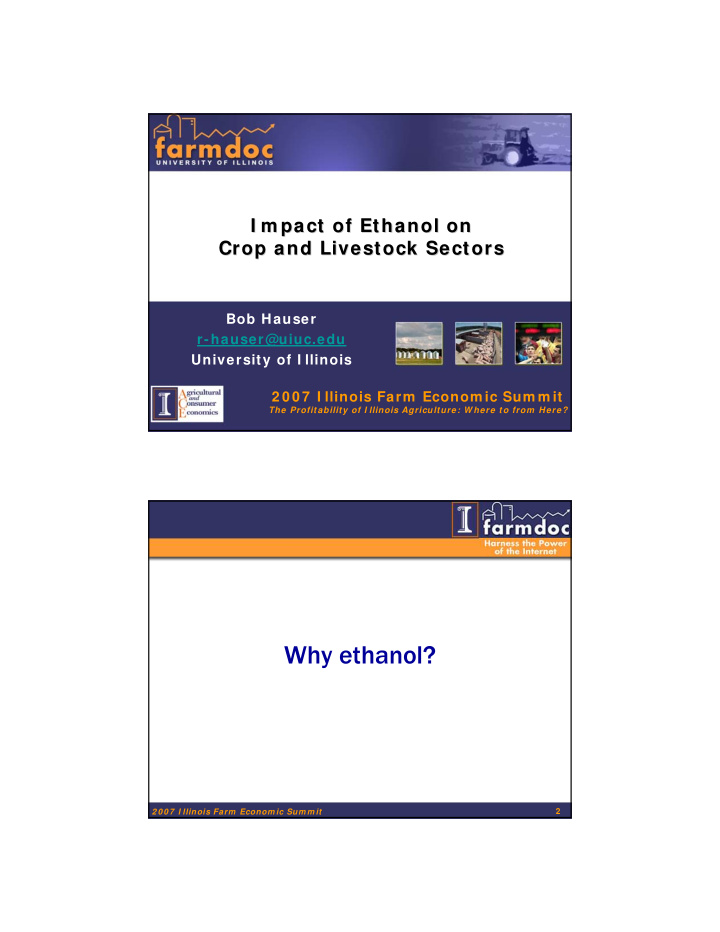



I m pact of Ethanol on I m pact of Ethanol on Crop and Livestock Sectors Crop and Livestock Sectors Bob Hauser r-hauser@uiuc.edu University of I llinois 2 0 0 7 I llinois Farm Econom ic Sum m it The Profitability of I llinois Agriculture: W here to from Here? Why ethanol? 2 2 0 0 7 I llinois Farm Econom ic Sum m it
Reason #1 100 90 80 70 Crude Oil Price ($/barrel) 60 50 40 30 20 10 0 1/2/1986 1/2/1987 1/2/1988 1/2/1989 1/2/1990 1/2/1991 1/2/1992 1/2/1993 1/2/1994 1/2/1995 1/2/1996 1/2/1997 1/2/1998 1/2/1999 1/2/2000 1/2/2001 1/2/2002 1/2/2003 1/2/2004 1/2/2005 1/2/2006 1/2/2007 3 2 0 0 7 I llinois Farm Econom ic Sum m it Reason #2 5.50 4.50 Price ($/bu.) $2.42 3.50 2.50 $1.14 1.50 0.50 Jan- Jan- Jan- Jan- Jan- Jan- Jan- Jan- Jan- Jan- 60 65 70 75 80 85 90 95 00 05 Month/Year Source: USDA 4 2 0 0 7 I llinois Farm Econom ic Sum m it
Reason #3 51 cents 5 2 0 0 7 I llinois Farm Econom ic Sum m it Resulting in: 6 2 0 0 7 I llinois Farm Econom ic Sum m it
Valuation of ethanol $2.00 corn $4.00 corn Mfg costs: $1.62 ethanol $2.34 ethanol Effect of: Co-products $1.39 $1.90 Subsidy $0.88 $1.39 7 2 0 0 7 I llinois Farm Econom ic Sum m it Other effects on value + � Meets RFS � Octane Booster � Oxygenate � State tax breaks _ � Gasoline substitute at about 67% � Blending, logistics, and transportation 8 2 0 0 7 I llinois Farm Econom ic Sum m it
World Biofuels 9 2 0 0 7 I llinois Farm Econom ic Sum m it Ethanol and Gasoline Prices 10 2 0 0 7 I llinois Farm Econom ic Sum m it
Omaha w holesale Gasoline Ethanol 2004: $1.25 $1.69 2005: $1.66 $1.80 2006: $1.94 $2.58 Jan 2007: $1.49 $2.26 Jul 2007: $2.49 $2.51 Oct 2007: $2.24 $1.79 11 2 0 0 7 I llinois Farm Econom ic Sum m it Ethanol-Corn Spread 12 2 0 0 7 I llinois Farm Econom ic Sum m it
Long run equilibrium corn price results from entry/exit into ethanol industry, driven mostly by: � Long run expectation of crude oil price � Expected level of federal subsidy 13 2 0 0 7 I llinois Farm Econom ic Sum m it Why is entry/exit so important w ith ethanol and not other uses? 1. Long run equilibrium price has been well below $3.50 2. Ethanol production will have a negligible effect on gasoline price, yet 3. It is a significant part (greater than 20%) of corn production 14 2 0 0 7 I llinois Farm Econom ic Sum m it
What adjustments w ill be needed to reach the new , $3.50 equilibrium 1. Depends on the elasticity of demand for other uses of corn 2. Depends on the elasticity of supply for corn as well as other crops 3. See Chapter 2 of Ethanol Report on CD if interested in details 15 2 0 0 7 I llinois Farm Econom ic Sum m it Where does it end?? � A high long-term oil price expectation dictates the corn price � There will be a movement up the non- ethanol demand curves for corn (mostly feed demand domestically and abroad), causing substitution of land � The form of this substitution world wide will depend on supply responses in those parts of the world that can add crop acres, perhaps Brazil and the Ukraine 16 2 0 0 7 I llinois Farm Econom ic Sum m it
Ultimately, in the U.S., the biggest effects are: � Increase in food prices (meat in particular) with relatively little decrease in consumption � A significant reduction in U.S. crop exports � Higher land prices/rents 17 2 0 0 7 I llinois Farm Econom ic Sum m it The push back to these conclusions tend to focus on: � Yields � Exports � CRP 18 2 0 0 7 I llinois Farm Econom ic Sum m it
Current CRP acreage 19 2 0 0 7 I llinois Farm Econom ic Sum m it Other factors determining the new state of equilibrium � U.S. subsidy policy – very important � RFS level -- ?? � 10% ethanol versus …? � Tariff policies – important but unlikely to change � Breakthroughs in cellulosic technology. 20 2 0 0 7 I llinois Farm Econom ic Sum m it
Cellulose versus corn � We know little about the economics of cellulosic processing, transportation, or production � Many questions remain at both the firm and sector levels � Appeal of cellulose usually based on � yield of ethanol per acre (miscanthus) � potential to grow it on “marginal” land � avoid direct food vs energy tradeoff � carbon valuation 21 2 0 0 7 I llinois Farm Econom ic Sum m it Preliminary estimates indicate � About a 60-cent per-gallon difference in ethanol cost when using miscanthus vs corn, when corn is $3.50 � Accounts for production, opportunity cost of land, storage/transportation, processing, with carbon value = 0 � Even when carbon is assumed to be $10/ton, the difference is close to 50 cents � If this is in the ball park then what would happen if the subsidy is aimed differently? � About a 90-cent per-gallon difference in ethanol cost when using miscanthus vs corn, when corn is $2.00 22 2 0 0 7 I llinois Farm Econom ic Sum m it
Finally, community impacts � Three locations in Illinois considered � Details are in Chapter 5 � General results � Local economic effects relatively small � Varies by level of urbanization 23 2 0 0 7 I llinois Farm Econom ic Sum m it Thank you! 24 2 0 0 7 I llinois Farm Econom ic Sum m it
Recommend
More recommend